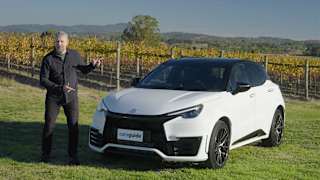The three M5 elements start with daily usability. We trundled out of Bathurst in electric mode, with the adaptive dampers (and other myriad settings) in Comfort.
The M5 has steel springs, double wishbone front suspension and a five-link rear axle, all of which has been heavily reworked by the boffins at M. Naturally, the ride is firm, though in Comfort the body moves through its motions smoothly.
The M5 is an effortless tourer, its eight-speed automatic shmoozing through ratios as it climbs and descends steep gradients. Wind and tyre noise insulation is good on coarse chip tarmac, though a bit more burble from the V8 would be appreciated.
The M5 has nine adjustable parameters to wake it up: 'Drivetrain', 'Energy Recovery', 'Drivelogic' (gear shift aggression), 'Chassis', 'Steering', 'Brake', 'M xDrive', stability control settings and 'M Sound'. Favourite settings can be stored to the wheel-mounted M1 and M2 buttons.
With the dampers still in Comfort the M5 remains fantastically capable with power delivery from the xDrive mighty rewarding on corner exit. Sport dampers sharpen the experience up further, amplifying the M5’s surprising agility. Thank the rear-wheel steer for this big sedan’s switchback performance.
Step beyond the limit of grip, brake too late, or get on the power too early, though, and the M5’s mass reveals itself rapidly. It doesn’t help that the accurate steering is devoid of feel. The brake-by-wire pedal is too numb and light, as well, making it tricky to judge grip levels on the road.
Feel is less of an issue on a dry Mount Panorama circuit, where the M5 turns out to be a total pussycat. The all-wheel drive, consistent dynamics, strong brakes and well-tuned stability control make for an approachable but seriously fast sedan.
The responsive transmission will hold gears to redline and is eager on the downshift in its most aggressive setting while tactile shift paddles make commanding ratio changes yourself that bit more engaging.
Prodigious punch out of corners is matched by the impressive consistency of the carbon ceramic brakes. The M5 pulled up for The Chase every time with minimal fuss, even from above 250km/h.
Similar credit goes to the 285mm front and 295mm rear Hankook S1 Evo tyres which remained consistent and predictable all day despite reaching temperatures over 130 degrees, according to the tyre pressure monitor.








































